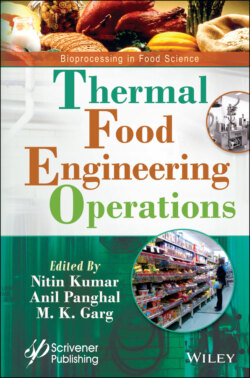Читать книгу Thermal Food Engineering Operations - NITIN KUMAR - Страница 47
2.6.1.2 Application for Inactivation in Food Sector
ОглавлениеDifferent studies were conducted which explain the different effect of the parameters of infrared radiation. Bacillus cereus on paprika powder was studied by applying radiation at 11 kW/m2 and 5 kW/m2 at a temperature of 95 °C [51]. From the studies it showed that maximum injury of microbes was seen at aw 0.5 and at aw 0.8 the overall log reduction was seen was 0.7 and 1.6 log 10 CFU/g at 5 and 11 kW/m2. From this, it was inferred that Bacillus cereus is susceptible to heating through infrared, plus also preserving the effects of the main product. A similar effect was studied for oregano powder where disinfection of the microbes was done for investigation [52].
Table 2.1 Application of thermal techniques in food industry.
| Technique applied | Food product | Targeted microorganism | Treatment parameters | References |
|---|---|---|---|---|
| Infrared Heating | Rice Powder | Bacteria & moulds | Wavelengths: 3.2, 4.5 and 5.8Time interval: 10, 20 & 30s | [91] |
| Almonds | Enterococcus faecium | Temperature: 70 °CTime: 1 h | [92] | |
| Garlics (shredded) | Aspergillus niger | Wavelength: 3.3 μm | [93] | |
| Oregano | Bacillus cereus | Temperature: 90 °CTime: 10 min | [52] | |
| Microwave Heating | Bay leaves | Counts of bacteria | Power density: 32.14–142.85 W/gTime: 150s | [94] |
| Peanuts | Aspergillus flavus | Power levels: 360, 480 & 600 W | [95] | |
| Infant Formula Mix | Cronobacter sakazakii | Power levels: 800 & 900W | [65] | |
| Ashitaba leaf powder | Colonies count | Power: 300 WTime: 1 h | [96] | |
| Radiofrequency Heating | Broccoli | Bacteria | Heating: 6kW | [74] |
| Barley Grass | Aspergillus and E. coli | Heating: 6kWFrequency: 27.12 MHzGap (electrode): 120-240mm | [96] | |
| Walnuts (shredded) | Staphylococcus aureus | Time: 40 minFrequency: 27 MHzGap (electrode): 19 cm | [97] | |
| Flour (wheat) | E. faecium and S. enteritidis | Frequency: 27 MHzTime: 39 min | [71] | |
| Instant Controlled Pressure Drop Technology | Apple Pomace | Aspergillus niger | Pressure: 0.2–0.6 MPa | [77, 100] |
| Dried Carrots | Flora of the bacteria | Pressure: 3 kPaTemperature: 70 °CTime: 3 h | [98] | |
| Seaweed | Salmonella spp. | Pressure: 0.44 MPaTime: 40s | [76] | |
| Flour (banana) | Colonies of bacteria | Pressure: 3–5 kPa | [99] | |
| Ohmic Heating | Apple juice | Salmonella Typhimurium, E. coli & L. monocytogenes | 30 V/cmTime: 60 s°Brix: 36 | [87] |
| Tomato soup | GeobacillusStearothermophilus | Frequencies: 60 Hz & 10 kHzTime intervals: 0, 15, 60, 120 sTemperature: 121°C, 125°C & 130°C | [83] | |
| Meat balls | L. innocua | HTST: 50 Hz8.33 V/cmTemperature: 95°CTime: 7 min | [88] | |
| Gochujang | Bacillus cells (vegetative) | Frequency: 60 Hz30 V/cmTemperature: 100°CTime: 2.5 min | [79] |
Eradicating the population of E. coli and Salmonella typhimurium was studied by [53] where 500W heating power was applied to the product, i.e., red pepper. After the treatment, it was seen the presence of 0.23 and 0.32 log CFU/g was seen for both the microbes and also maintain its intercellular component and color of the product. Though the volatile content present in the above products, the volatile oil seems to get affected with some infrared heat setting, there some wavelength was not considered for the preservation process of these types of the volatile content of the product.
Various types of food sustain different wavelengths in infrared radiation. So, it is essential to evaluate the pattern of absorption to make the inactivation process easier and ensure proper deactivation without hampering the quality of food. For sensitive foods, it should be taken care of to heat the microbes selectively so that they would not hamper or adversely affect the components of the food. The wavelength selected for protein denaturation for decontamination of F. proliferatum and A. niger results in 40% increases in the inactivation process. Overall, it can be decided that though the product temperatures before and after infrared heating identical and injury of spores and cell wall augmented with infrared heating [54]. The applications of thermal processing in food sector has been discussed in Table 2.1.
